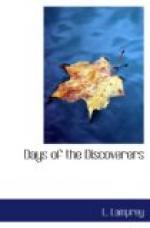John Hudson found new interest in Latin.
When Captain Smith began to talk of joining a new colony to go to Virginia the boy begged hard to be allowed to go. But just at this time the Muscovy Company was sending Henry Hudson to look for a way round through northern seas to the Spice Islands. The Dutch were already trading in the Portuguese Indies. If England could reach them by a shorter route, it would be a very pleasant discovery for the Muscovy Company.
Even in 1607 geographers believed in an open polar sea north of Asia. Hudson tried the Greenland route. Sailing east of Greenland he found himself between that country and the islands named “Nieuwland” by William Barents the Dutch navigator in 1596. Their pointed icy mountains seemed to push up through the sea. Icebergs crowded the waters like miniature peaks of a submerged range. Hudson returned to report to the company “no open sea.”
In 1608 he was again sent out on the same errand. This time he steered further east, between those islands and another group named by Barents Nova Zembla. He sailed nearer to the pole than any man had been before him, and found whales bigger, finer and more numerous than anywhere else. Rounding the North Cape on his way home he made the first recorded observation of a sun-spot. In August, when he returned and made his report, there was a sensation in the seafaring world.
The Dutch promptly sent whaling ships into the arctic seas, and suggested, through Van Meteren the Dutch consul in London, a friend of Hudson, that the English navigator should come to Amsterdam and talk of entering their service. While there, he received an offer from the French Ambassador, suggesting that his services would be welcome to a proposed French East India Company. Hearing this, the Dutch hastened to secure him, and on April 4, 1609, he sailed from Amsterdam in a yacht of eighty tons called the Half Moon and shaped rather like one, manned by a crew of twenty, half English and half Netherlanders, and John as cabin-boy.
John was in such a state of bliss as a boy can know when sailing on the venture of his dreams. His father had told him in confidence that as his sailing orders were almost the same as the year before, he did not expect to find the northern route to India in that direction. Failing this the Half Moon would look for it in the western seas. Of this plan he had said nothing in Holland.




